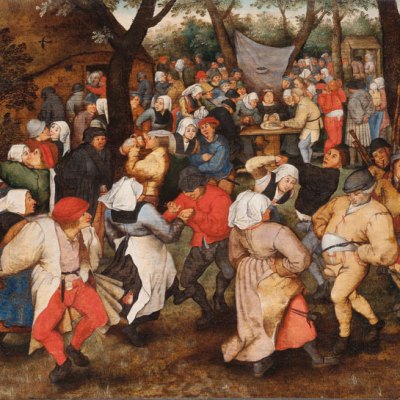
Between 1400 and 1650, the corner of Western Europe known today as Flanders was a crucible of culture. The pocket of land framed by Bruges, Antwerp, Brussels and Leuven had become wealthy through trade and the renowned skills of its weavers, a wealth reflected today in the splendour of its architecture and the astonishing artworks within its churches and museums. This piece of Christendom was far more than a centre of international trade, however. As successive powers fought to rule the region, it played host to a ferment of ideas and conflicting visions: the ideas of Martin Luther took hold in the early 16th century, to be followed by the Counter-Reformation orthodoxies imposed by Catholic Spain.
From this turbulent cradle, a new civilisation arose – known today as the Northern Renaissance. It dawned in the work of the Flemish Primitives, led by Jan van Eyck (c. 1390–1441), who pioneered the use of oil paint in his portraits and altarpieces to create meticulous, realistic depictions of surface effects and natural light. It reached peaks of audacity in the landscapes and scenes of ordinary life by Pieter Bruegel the Elder (c. 1525–69), acknowledged as the greatest Netherlandish painter of the 16th century and admired ever since for the exceptional moral quality of his teeming compositions, as well as his technical virtuosity. The era found its ultimate expression in the lavish, sensuous baroque masterpieces of Peter Paul Rubens (1577–1640) – painter, art collector, polyglot and sometime diplomat.
The Grote Markt, Antwerp. Photo: © Piet De Kersgieter
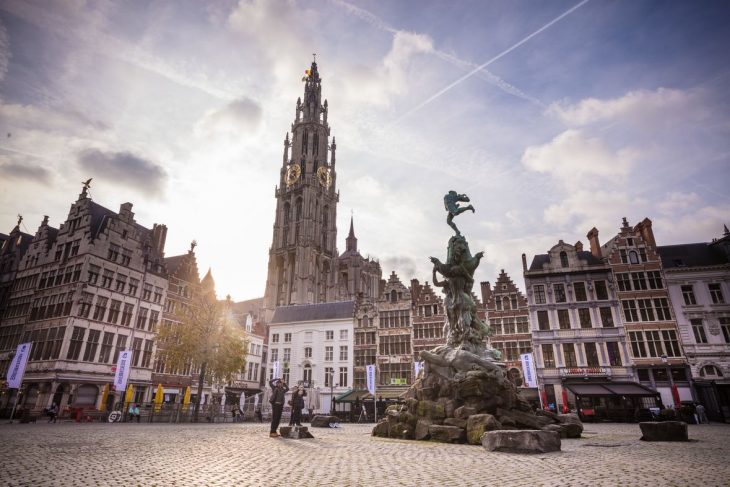
There has never been a better time for visitors to Flanders to explore the work of these artists. Flemish Masters, a three-year programme celebrating their achievement, is an invitation from the region to encounter these pre-eminent creative personalities in the unique context that shaped them. In Bruges and Ghent you can walk in the footsteps of Jan van Eyck, threading the same late-medieval streets that the artist would have known; throughout the region you can still encounter the rural landscapes, picturesque villages and striking buildings that informed Bruegel’s vision; and in Antwerp many of Rubens’ masterpieces still hang in the churches, private homes and institutions for which they were first commissioned.
Ghent Altarpiece (1432), Jan van Eyck and Hubert van Eyck. St Bavo’s Cathedral, Ghent. Photo: Hugo Maertens; © Lukasweb.be/Art in Flanders VZW

Last year the focus was on Rubens. And in 2020, attention will shift to Jan van Eyck, as the final panels of the artist’s tour de force, the Ghent Altarpiece, are restored to St Bavo’s Cathedral as the culmination of a conservation project that began in 2012. In 2019, however, in what is the 450th anniversary of his death, the spotlight is on Pieter Bruegel the Elder – with special exhibitions planned throughout Flanders.
Bruegel was born around 1525, possibly in or near Breugel, a village in what is today the Netherlands. Little is known about his early life, but it is recorded that he learned to paint in Antwerp, in the studio of the versatile court painter, architect and sculptor Pieter Coecke van Aelst, whose daughter Bruegel later married, and that in 1551 he was admitted to the Guild of St Luke, the city’s professional body for artists. He then took off for Italy on a journey that lasted until 1554. As well as absorbing the lessons of Italian masters such as Michelangelo, Raphael and Giulio Romano, Bruegel was powerfully impressed by the Alpine landscapes he passed through, producing drawings that formed the basis for some of his most stirring and fantastical landscapes. On his return, Bruegel settled in Antwerp, then an international centre of humanist learning and print and book publication (you can learn more about this at the Plantin-Moretus Museum, which occupies the site developed by the trailblazing publisher Christophe Plantin in the 1570s). Here he produced at least 40 designs for prints for Hieronymus Cock, at the time the most important print publisher in northern Europe, and an ingenious craftsman and entrepreneur. Little wonder, then, that in his own era Bruegel was more famous for his prints than for his paintings.
Big Fish Eat Little Fish (1557), Pieter van der Heyden after Pieter Bruegel the Elder. Royal Library of Belgium, Brussels

This context is brought to life this year by two exhibitions in Brussels. At BOZAR, ‘Prints in the Age of Bruegel’ (until 23 June) scrutinises print production in the Southern Netherlands in the 16th century, of which Bruegel’s output is but a small, if crowning, part. Later on in the year, the Palace of Charles of Lorraine, newly restored to its 18th-century magnificence, plays host to ‘The World of Bruegel in Black and White’ (15 October–16 February 2020), a display of the complete collection of Bruegel prints held by the Royal Library of Belgium. Here you’ll be able to pore over Bruegel’s Italian landscape sketches and preparatory drawings, as well as his virtuoso prints in different impressions. While in Brussels, be sure to visit the Royal Museums of Fine Arts of Belgium, where the Bruegel holdings include three great masterpieces (only 40 or so paintings by him are known): The Fall of the Rebel Angels (1562), a storm of surreal imagery, and Winter Landscape with a Bird Trap (1565) and The Census at Bethlehem (1566), rich with subtle allegories and closely observed detail. The museum has developed extensive digital projects relating to Bruegel, including its ‘Bruegel Box’ – a series of immersive videos that envelop visitors in his paintings.
Winter Landscape with a Birdtrap (1565), Pieter Bruegel the Elder. Royal Museums of Fine Arts of Belgium, Brussels. Photo: Johan Geleyns
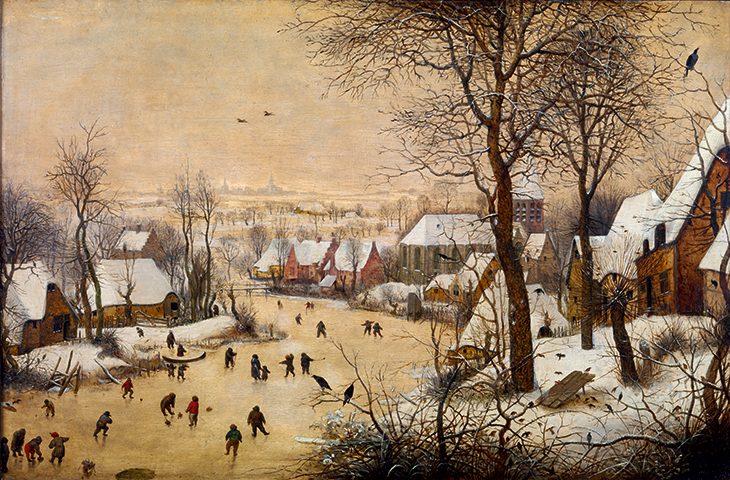
In 1563, the year of his marriage, Bruegel moved to Brussels to be closer to the wealthy patrons who supported him. By now he was a successful artist. To garner a more intimate sense of Bruegel’s Brussels, visitors will be able to take a virtual-reality journey back to the 16th century at Halle Gate, a preserved section of Brussels’ medieval wall (‘Back to Bruegel’; 18 October–18 October 2020), while the Palais de la Dynastie is hosting an experiential exhibition that promises an animated, interactive encounter with the artist’s imaginary universe (‘Beyond Bruegel’; 6 April–31 January 2020).
The Halle Gate, Brussels. Photo: KMKG-MRAH
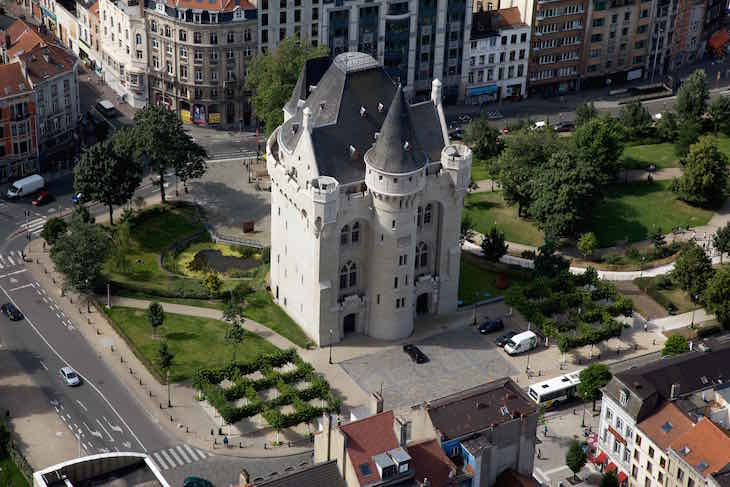
Alternatively, you can simply wander through the Sablon, the 16th-century quarter where the nobles of the day took up residence and, in the Marolles district, visit the impressive Church of Our Lady of the Chapel, where the artist married and where he is buried – and where, this year, 10 three-dimensional figures from his painting have taken up residence, waiting to be discovered. Just outside Brussels, the romantic Gaasbeek Castle, restored in the 19th century, is hosting ‘Feast of Fools: Bruegel Rediscovered’ (7 April–28 July), an exhibition of artists who have, since the modern revival of interest in his work that began around 1900, been inspired by Bruegel.
Dulle Griet (Mad Meg) (1563), Pieter Bruegel the Elder. Museum Mayer van den Bergh, Antwerp. Photo: KIK-IRPA
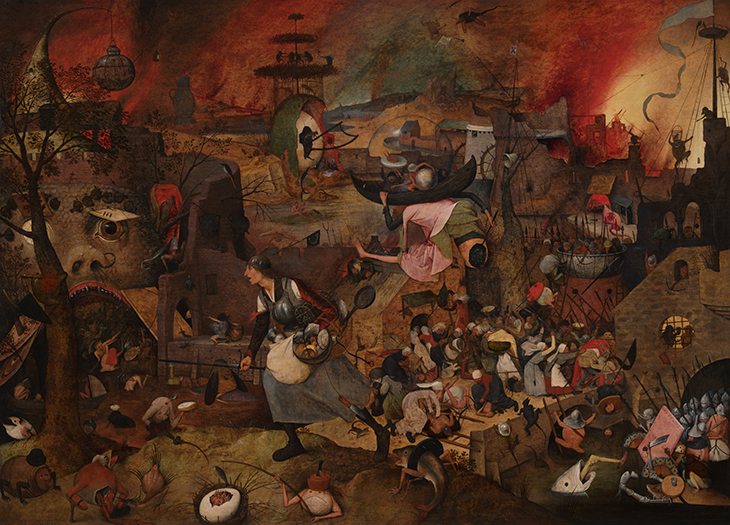
A final stop, however, must be back in Antwerp, where Bruegel’s career began. Here, at the Museum Mayer van den Bergh, his spectacular, nightmarish masterpiece Dulle Griet (Mad Meg; 1563) is once again on display after a two-year restoration project. On 5 October, it will be 125 years to the day since the collector Fritz Mayer van den Bergh bought the painting at auction in Cologne. Restored to its original brightness, Mad Meg will form the centrepiece of an exhibition later this year devoted to Mayer van den Bergh’s collecting and that of the earlier, highly influential collector Florent van Ertborn, who in 1840 bequeathed 115 paintings to the city of Antwerp (‘From Fouquet to Bruegel’; 5 October–31 December 2020). Both recognised, ahead of their era, the outstanding quality and cultural significance of the early Flemish masters – painters now acknowledged as some of the most imaginative and innovative of all time.
To find out more about about Bruegel-related exhibitions and events in Flanders this year, visit www.flemishmasters.com.


